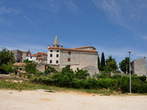Kanfanar is a small settlement on the plateau, east above Limska Draga. It lies on an open plain and is widely graded along the fields. The settlement is the seat of the municipality in the interior of western Istria between Zminj and Rovinj. It used to be an important crossroads of road and railway routes.
The place developed with the relocation of the inhabitants of Dvigrad to Draga after the plague in 1630. The area was already inhabited in prehistoric times, in the Roman era and in the Middle Ages. Kanfanar is mentioned for the first time in 1096 in a document of the Patriarch Volrik of Ogle. An early Gothic stone pulpit from the 13th century, two wooden statues from the 15th and 16th centuries, a painted door from the 16th century and illuminated church books from the 15th century were transferred from the Dvigrad church to the Kanfanar church. Today, all of this is located in the parish church of St. Silvestra, which was built in 1696, on the site of an older church and enlarged in 1714. In the area of the older church, a new church of St. Valentine was built in the 18th century. In the apse of the Romanesque chapel of St. Agate, which was built in the 11th to 12th century, has frescoes from that time. They are the oldest Romanesque folk art frescoes ever discovered in Istria. Along the road to Dvigrad are the ruins of the Benedictine monastery with the church of St. Petronile, characterized by Romanesque-Gothic style.
The inhabitants are engaged in animal husbandry and agriculture, but also work in the stone industry. There is a railway station for Rovinj in Kanfanar, but the road connection Pula - Trieste, which is about seven kilometers away, has avoided it.












